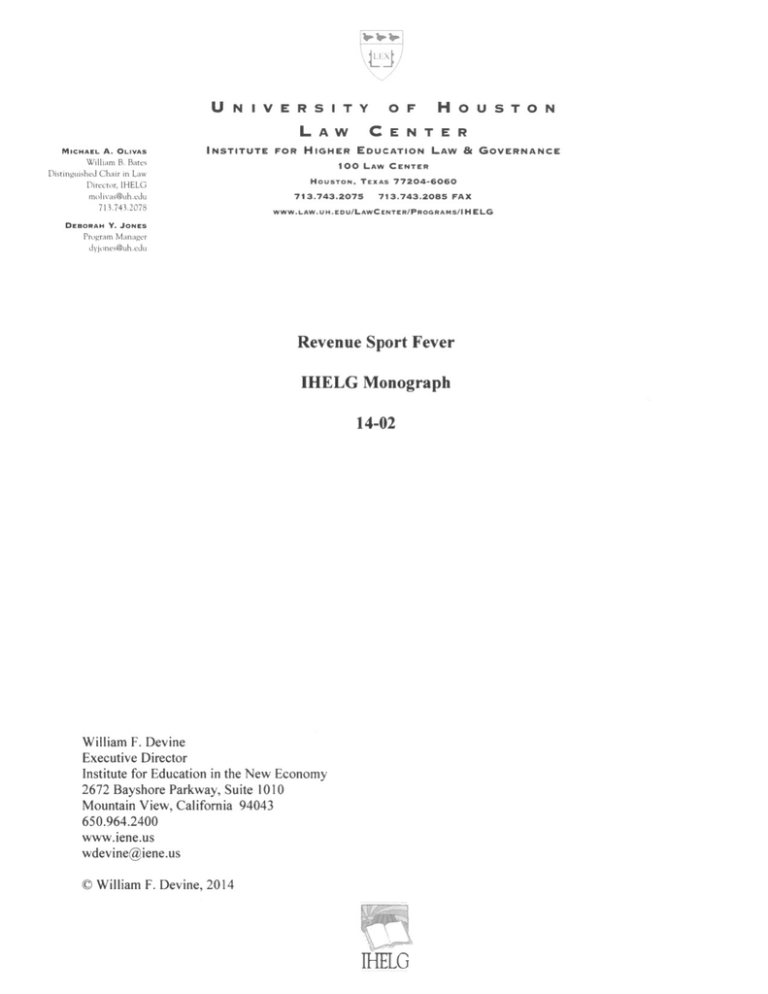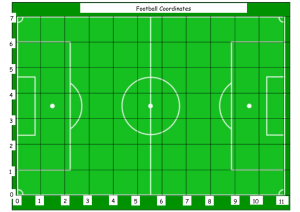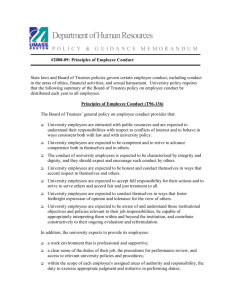
Revenue Sport Fever
By William F. Devine
The day of reckoning in the to-pay-or-not-to-pay debate over college revenue sports—a day
many higher education advocates have awaited for decades—is just about here. For this we can
thank four high-energy legal collisions that are set up around the country.
In Chicago, Northwestern University is fighting its football team’s attempt to unionize. The
team has held a vote on whether to join a union. The University has countered with light union busting.
The National Labor Relations Board regional director Peter Sung Ohr ruled that the scholarship
players are University employees who can vote on whether to unionize. The University's appeal of
that ruling is pending. The players want to bargain for improved medical coverage, better
scholarship terms, and a post-eligibility education fund.1
In federal court in Oakland, the players bringing the O’Bannon antitrust class action want the
right to earn income from broadcast companies, apparel makers, and anyone else willing to pay
them.2 The sporting association operated by trustees at 1,066 of America’s universities3 wants the
court to uphold rules that prohibit such income. Pre-trial sparring lasted four years. Trial kicked off
on June 9.
Still in Oakland, a former West Virginia University running back has also hit the sporting
association with a class action complaint. At stake is whether the court should order the association
to increase the amount of athletic scholarships to the full cost of attending college.4
And in federal court in New Jersey, a group of basketball and football players have launched
what might be the most ambitious class action against the sporting association. They want to
remove all rules against player compensation, which the sporting association currently limits to a
scholarship.5
1
Copyright 2014 by William F. Devine.
All rights reserved worldwide.
Many people believe that all the custom-designed legal work generated by these collisions
will yield one of two outcomes: university trustees will pay the players, or they will not. Yet in fact
the trustees have three outcomes to consider, and the one they aim for will tell us a lot about the role
higher education will play during coming decades as America tries to rebuild from the global
financial crisis.
I
If the trustees fight these cases, win, and maintain the no-pay-for-play status quo, they
perpetuate three problems.
First, they continue to operate programs that conflict with their missions and charters. At
Michigan State University, for example, the mission is “to advance knowledge and transform lives
by: providing outstanding undergraduate, graduate, and professional education to promising,
qualified students in order to prepare them to contribute fully to society as globally engaged citizen
leaders...” 6 In light of this mission, one sees why the University has a Physics Department, but not
why it has football and basketball teams. Football and basketball are not named in this mission, and
their educational value for an institution cultivating “globally engaged citizen leaders” is
insignificant.
Football, for example, teaches fortitude, discipline, patience, commitment, grace in success
and defeat, and the principles of breaking down a Cover-2 zone. These lessons are fine, but most of
them could be learned while working for a successful painting contractor willing to share his
subscription to All-22.7 They are available as part of a well-coached AAU or high school football
experience. Academically speaking, they do not compare to writing a 137-page thesis on the role of
monetary policy during the Great Depression. Like spelling and subtraction, they are useful, but
lack the substance necessary to have a place in a university curriculum.
2
Copyright 2014 by William F. Devine.
All rights reserved worldwide.
No matter how much the trustees protest that players are students, not employees, the truth
about the educational value of revenue sports does not change.
If the trustees continue the no-pay-for-play status quo, they also continue to operate an
enterprise that conflicts with their own rule about commercial exploitation of players. The key
provision here is Article 2.9 in the constitution of the trustees’ 1,066-member sporting association.
It states that players “…should be protected from exploitation by professional and commercial
enterprises.”8 The problem is that the trustees’ own commercial enterprise operates as if this
provision does not exist.
At the heart of the trustees’ enterprise are television contracts worth approximately $22.6
billion for football games and approximately $10.8 billion for basketball games. Universities,
coaches and athletic directors in the power conferences all want to score large cuts of this cash, and
they succeed. Northwestern’s football revenues in 2012-13 included $19 million of television
money.9 Ohio State football coach Urban Meyer earns $4 million.10
What about the players? Universities, coaches and athletic directors score their cash when
games are won, so the cash-based pressure on players to win is colossal. Yet the rules limit players
to no union representation, minimal compensation, and barely-there medical coverage.
So—the trustees write a rule that says they stand for protecting players from commercial
exploitation, yet they run an enterprise that subjects the players to the forces of a $33 billion
sweepstakes in which windfalls can be gained by only a relative handful of parties, all of whom have
control over players’ lives, but none of whom are players.
The fact of this trustee exploitation is not washed away by having the sporting association’s
attorney report that some players say they play “for the love of their sport and not to be paid.”11
That report merely identifies the impulse that drives players to keep signing up for the exploitation.
3
Copyright 2014 by William F. Devine.
All rights reserved worldwide.
As for the reach of this trustee exploitation, it extends further than is first apparent. Some
coaches and athletic directors at Division II and III schools, eying the rewards of a job at a sports
power, use performance at smaller schools to score higher-paying jobs at power conference schools.
As in the power conferences, these scores are made when games are won, so the cash-based pressure
on players to win can be colossal, and thus the forces of the $33 billion sweepstakes extend through
all levels of the 1,066-institution sporting association.
No matter how much the trustees profess commitment to the players’ educational well-being,
those professings will not dissolve the conflict between Article 2.9 and the exploitive truths about
the trustees’ commercial enterprise.
Finally, if the trustees continue the no-pay-for-play status quo, with its non-educational,
exploitive qualities, they continue modeling for students, with every prime-time football and
basketball telecast, a problematic lesson: find a cash flow, get in front of it, and keep it flowing
regardless of what values you compromise or who you exploit.
We have recently witnessed lapses in values from leaders at Toyota and General Motors, and
before that from firms that triggered the global financial crisis. We have also witnessed the costs of
these lapses to families and the nation. Viewed through the prism of these lapses and costs, the
problematic lesson modeled in the no-pay-for-play status quo might well make the universities
unworthy of the income tax-free status that the government grants to them. One could also argue
that, at a time when we need to cultivate university graduates who can both survive and rejuvenate
the economy, the problematic lesson modeled in the no-pay-for-play status quo makes trustees look
more like part of the rubble than part of the rebuild.
II
What happens if the trustees, either through losing the cases or settling them, abandon the
status quo and agree to share revenue with the players?
4
Copyright 2014 by William F. Devine.
All rights reserved worldwide.
First, let’s define “share.” Note as a point of reference that the revenue split between NFL
owners and players is approximately 1 to 1.12 By contrast, the revenue split between the University
of Texas and its players in recent years has been about $95 million (the University’s 2010 football
revenues) to $3.2 million (the University’s 2010 cost for football scholarships), or 29 to 1.13 So for
the trustees’ commercial exploitation of players to end, and for the trustees’ value-compromised,
exploit-who-you-must lesson to cease, and for the trustees to arrive at a point where they are indeed
sharing revenue, the trustees must travel a long economic road.
Even if revenue sharing begins, exploitation ends, and the value-compromised, exploit-whoyou-must lesson ceases, however, other problems will arise. How much will the cost of a
university’s Title IX compliance rise if trustees split their basketball and football revenues with
players? Will a revenue split with players cause basketball and football income lose its tax-free
status, thereby damaging the trustees’ basketball and football business model,14 and perhaps other
university income streams?
Meanwhile, some coaches and ADs at Division II and III schools will still be trying to score
higher-paying jobs at power conference schools, so colossal cash-based pressure on to win will still
be exerted on unpaid players, and echoes of commercial exploitation will still reverberate.
Perhaps most importantly, the disconnect between an increasingly complex, essentially forprofit revenue sport enterprise, on the one hand, and the university missions and charters, on the
other, will be even more prominent than it is now. How will university students respond to such a
high-profile disconnect at their institutions? At a time when, as Nobel laureates keep pointing out,
the economy keeps setting a new standard for degree of difficulty,15 one wonders if students can
survive and rejuvenate the economy if schools, instead of being the full-functioning educational
institutions they were founded to be, become a set of confused, shoulder-padded stand-ins.
5
Copyright 2014 by William F. Devine.
All rights reserved worldwide.
III
What is the trustees’ third option? Stick to the work outlined in the missions and charters,
and abandon not just revenue sports but the entire sporting association model. This option has five
reasons to recommend it.
First, the strategic thinking to support it is already in place. At Penn State, for example,
where the trustees oversee a total enrollment of 96,000 students and a budget of $4.4 billion,
compared to a football team with 100 players and a $20 million budget16, the Strategic Plan states—
Penn State is already a very efficient institution that has accomplished great things
with limited resources, but the University needs to think very deliberately now about
the choices that it makes—including, perhaps, to shrink, consolidate, or eliminate
some programs and activities—in order to build on areas of existing strength and
invest in promising new ideas. ...17
A decision to eliminate the sporting association model would fit right into this type of
strategic thinking for a simple reason: the trustees operate that 1,066-member sporting association,
but that is not what they do best, nor presumably is it what they aspire to do best.
Second, sports survive. They do not need to go away, nor are they likely to do so. Students
who want to play sports on campus will use the facilities to play them. Those who want to play
football, basketball, softball, soccer or any other sport in semi-professional, pre-Olympic leagues
will find a place to play. The AAU or some other set of professionals will emerge to handle the task
of running those leagues. Freed from academic constraints, those leagues might well run even better
than they do now.
Third, the exploitation of players by the trustees’ commercial enterprise goes away.
Fourth, the trustees’ value-compromised, exploit-who-you-must lesson goes away.
Fifth, by staking each institution’s reputation on the education of all students, not on the
reverence for 115 football and basketball players, trustees would send a message that they can be
relied upon in rebuilding America to new levels of prosperity—not just in terms of developing
6
Copyright 2014 by William F. Devine.
All rights reserved worldwide.
student talents, but also in terms of setting an example that instills values and models the courage
and self-honesty to use values to make difficult choices. Freed from the burden of running a
sporting association that is not their strongest suit, universities could devote more resources to the
educational work for which they were intended, and for which they are so needed.
*
So those are the three possible outcomes that the four high-energy legal collisions seem
likely to yield for America’s university trustees. Each particle of each outcome carries consequence
for higher education. We are all on edge waiting to see which outcome the trustees pursue.
William F. Devine directs the Institute for Education in the New Economy. He also heads the
Corporate & Education Governance practice at William Devine Esquire, a Mountain View,
California law firm. He is the author of Penn State’s Other Cover-up (Smashwords 2014), and
Women, Men & Money (Random House, 1998). He once spent a season coaching college
basketball.
1
Barry Petchesky, “Northwestern Football Players Are Trying to Unionize,” Deadspin.com, 28 January 2014.
Ben Strauss and Steve Eder, “College Players Granted Right to Form Union,” New York Times, 26 March
2014. Tom Farrey, “NW Union Reps Off to Congress,” ESPN.com, 31 March 2014. Steve Berkowitz,
"House Panel Grills College Leaders on Unionization," USA Today, 8 May 2014.
2
Stewart Mandel, “Judge Allows Ed O’Bannon v. NCAA Lawsuit to Proceed to Trial,” CNNSI.com, 20
February 2014. William F. Devine, "NCAA Suit Is about Class," San Francisco Chronicle, 10 June 2014.
3
“About the NCAA/Membership,” NCAA.org.
4
Associated Press, “Shaune Alston Suing NCAA, Others,” ESPN.com, 6 March 2014.
5
Tom Farrey, “Jeffrey Kessler Files against NCAA,” ESPN.com, 18 March 2014.
6
“MSU Mission Statement,” Michigan State University.
7
All-22 is a film service that allows the viewer to see and analyze all 22 players on every play in an NFL
game. See Michael Lombardi, “NFL Opens Pandora’s Box by Offering All-22 Tape to Public,” NFL.com, 22
June 2012.
8
See Bylaw Article 2.9, Division I Manual, 2011-2012, NCAA.org.
9
Stu Durando, “Big Ten Payouts Hit $25.7 Million per School,” St. Louis Post-Dispatch, 6 May 2013.
7
Copyright 2014 by William F. Devine.
All rights reserved worldwide.
10
Greg Bishop, “For New Coach at Ohio State, It’s First Down and $4 Million,” New York Times, 28
November 2011.
11
“NCAA Disagrees with Union Decision,” NCAA.org, 26 March 2014.
12
Liz Mullen, “NFL Players See Potential Revenue Win,” Street & Smith’s Sports Business Journal, 1
August 2011.
13
Stefan Stevenson, “Texas Football Leads the Way among Cash Cows,” Fort Worth Star Telegram, 4
December 2012. “2010-2011 Football Expenses,” The Business of College Sports.
14
Once players are paid, the sporting association will have a harder time maintaining that the competition it
fosters is amateur, so its tax exemption, which depends on fostering amateur competition, will be jeopardized.
Similarly, the member schools will likely find their tax exemption jeopardized. At the moment the IRS views
school athletics as substantially related to a school’s educational activities, and since all income derived from
educational activities is exempt from income tax, income derived from school athletics is exempt from
income tax. Once players are paid, their amateur status would seem to disappear and the likelihood that the
IRS would view the games as substantially related to educational activities would seem to decline.
15
See “Nobel Laureate Joseph Stiglitz on America’s Lost Decade,” The Takeaway, 23 August 2011; Paul
Krugman, “Wasting Our Minds,” New York Times, 29 April 2012; and Joseph Stiglitz, “America Is No
Longer a Land of Opportunity,” Financial Times, 25 June 2012.
16
“Penn State Budget Primer,” Pennsylvania State University. “Fall to Fall Enrollment Comparison, 2012
and 2011,” University Budget Office, Pennsylvania State University. “Roster, Penn State Football,”
Pennsylvania State University. Chris Isidore, “College Football’s $1.1 Billion Profit,” Money, 29 December
2010.
17
“Priorities for Excellence: The Penn State Strategic Plan, 2009-2010 through 2013-2014/Creating the
Plan,” Pennsylvania State University.
8
Copyright 2014 by William F. Devine.
All rights reserved worldwide.





